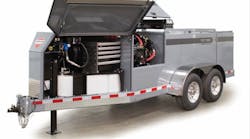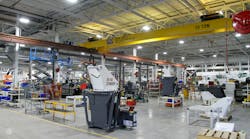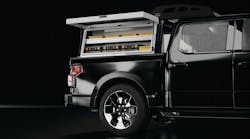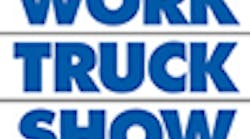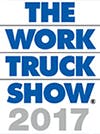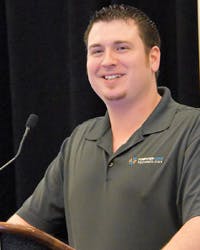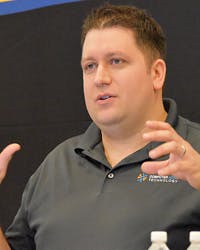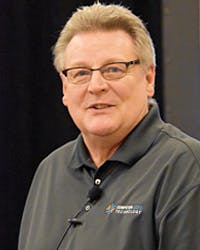Leveraging 3D design and manufacturing tools can help optimize the manufacturing process—reducing costs, saving time, speeding production, eliminating waste, and decreasing risk—according to presenters from Computer Aided Technology LLC.
The presentation, “Rapid Prototyping for Small and Mid-Sized Companies,” explored the product development life cycle from design to manufacturing and addressed technologies including 3D CAD, CAM, validation, visualization, 3D scanning, and 3D printing, with input from application engineers Bob Renella and Derek Ellis Sr and emerging products manager Bob McGaughey.
“Time and money are big,” Renella said. “First to market always wins.”
“The product life starts out with a concept,” Renella said. “Everybody has done this. Whether you’re doodling or doing something else, you’re building something. We all know you’re going to edit this idea over and over. So it’s a little napkin sketch. You’re sitting out on a patio talking to your buddy. You draw it out for him.
“You can make a quick 3D CAD model. Maybe you have a CAD system. It’s a little fancier than a sketch. Or maybe you actually make yourself models and mockups out of clay or cardboard.”
Renella said it’s important to use industry knowledge to design in 3D CAD, commonly known as DFM (design for manufacturability) or DFA (design for assembly).
“It doesn’t do us any good if the parts don’t fit,” he said. “That’s not going to work. Perform a simple design analysis.”
In the manufacturing stage, prototyping is important, even if it’s in a 3D printed mold.
“Is it going to give you a million parts? No,” he said. “It’ll never do that. But if you get 10, so be it. If you find out that your date is in the wrong location or the insert is in the wrong location or the mold isn’t even filling, that’s a cheap fix. There’s also low-volume tooling—injection mold simulation—and 3D-printed, end-use parts, which are material-dependent.”
Validation involves quality control, first-article inspection, and form, fit, and function to determine what you are getting back from your supplier.
McGaughey discussed 3D scanning in the industry, going through requirements and specifications:
• Competitive product analysis.
“You get a competitor’s part and want to analyze it. You have a short period of time with it and want to get as much information off it as possible. So we use a 3D scanner—state of-the-art technology—scan the part and then analyze it to get accurate data.”
• Measurement of the product environment or connecting surrounding parts, creating a CAD model.
• Measurement of existing parts for aftermarket or custom equipment.
Concept and design:
• Clay model measurement/reverse-engineering (RE). “We have a lot of organic surfaces and organic designs. How do I translate that back into my CAD? You want a guideline to start with. So using new technology—3D scanners—you can scan your clay model and use that information to reverse-engineer it back in the CAD system.”
• Models and mock-ups measurement/RE.
• Styling and aesthetics.
Concept prototyping:
• Integration of prototype modifications into CAD file.
• Form study, proof-of-concept prototypes.
• Ergonomic prototypes.
CAD design:
• 3D scan-to-CAD, reverse-engineering (extracting design-intent), and packaging design.
“After you get the scan what do you do with it?” McGaughey said. “
Yeah, scans are pretty, but once you scan it, unless you know what you’re going to do with it, it’s pointless. Sometimes when we get done with the scan, we go directly to CAD. So there are certain venues and software out there we can use to either extract data, that sort of thing.”
Prototyping:
• Rapid prototyping/manufacturing.
• Integration of prototype modifications into CAD file.
• Prototype inspection.
“Sometimes you can take a scan of something and take it directly to prototype. You can take that piece of clay, scan it, and 3D print it out of production material.”
Testing, simulation, and analysis:
• Finite Element Analysis (FEA).
• Interference analysis.
• Deformation, geometry analysis.
“You can also do an FEA (finite element) analysis. A good example of that: I have had this part for 50 years and someone says, ‘You know, we really want to try this out of different materials, but we don’t have a CAD model.’ There are some CAD systems that when you do the FEA analysis, you can take the match from the scan and perform an FEA analysis. That’s the great thing about bringing in the CAD. You can do those quick what-if scenarios. You can say, ‘OK, I did this out of say, high-density polyethylene, but then I want to do it out of glass-filled nylon.’ Or you can say, ‘I really need some cast-hardened steel.’ It’s simply going in and right-clicking ‘change material’ and running the analysis again.”
Tooling design:
• Tooling validation/inspection.
“Many times we have great machines, but if we don’t get all the information we really needed, you may have a part that doesn’t match the print. Now, we may not have had our best machinist on it. We may have had an apprentice machinist. We may have sent this over to another country to have it manufactured and sent back. So being able to take a scanner, scan that surface and then say, ‘Lay it right on top of the CAD, and how far in and out, is that acceptable? Is that within our manufacturing tolerances?’ ”
Assembly/production:
• Part assessment before machining.
• Virtual assembly.
• Tool/robot path programming.
“I was in St Louis a year and half ago and visiting a motor company. I’m like, ‘What kind of motors do you do?’ He said, ‘We do anything from ½ horse up to about 1000 horse.’ I’m like, ‘Wow that’s a big motor. How big is that?’ We go out to the shop floor. I don’t expect them to scan something this big. It’s literally nine feet tall. I got thrown into the middle of an argument between an intellectual engineer and a mechanical engineer. They flipped the switch. I heard the most awful noise on the planet. They had handed me ear protection before they turned it on, and it still sounded like 120 decibels going off my ears. The mechanical engineer is saying, ‘The timing is off on the electronics.’ The intellectual engineer is blaming the mechanical engineer. We ended up scanning the whole motor with the insert inside. I had them take it with a hoist and pull it out and set it down. We scanned the guts of the motor inside and the guts that was pulled out. Because I scanned them as they were assembled the first time, the software snapped them together like they were assembled. So then I was able to cut a section through something that they would have had to cut the part in half to see. I was able to see there was less than 8/1000 gap between the bottom of the stator and the actual motor. I’m not sure if I answered the argument between them, but I can do something that I was never able to do when it was actually put together.
“Another example was International Truck. We took the hood and left it off. We scanned the whole front end—hood, fenders, grill. They said, ‘The most important thing for us is clearance between the motor and under part of the hood.’ So we just disconnected the hood, set it to the side, scanned the motor, put the hood back on, lifted it back on, and scanned underneath the hood. The software still remembered because the hood was down when it was first assembled. It snapped the bottom of the hood and the top of the hood together as if it was still assembled. I was able to see I had a six-inch gap between the covering underneath the hood and the top of the motor. They wanted to put a supercharger in there. They were able to do that. The only way they were able to do that before was hopefully get somebody on their back and wheel something up there.”
How do you find the right tool for the job? McCaughey said Computer Aided Technology LLC has a wide variety of 3D scanners.
“It all comes down to accuracy,” he said. “What is the accuracy of your parts?”
MetraSCAN is for larger parts. He said Indianapolis Motor Speedway used to require 30 minutes to inspect every air foil of the cars, but now can do it in one minute with a MetraSCAN.
The HandySCAN 700 uses triangulation on reflective targets and has metrology-grade measurements with accuracy of up to 0.030 mm, resolution of up to 0.050 mm, high repeatability, and a traceable certificate.
“There is no way in the ASME code to actually say what the best quality of a measuring device is,” he said. “You can only say what the worst is. So those accuracies are not the best. That is the worst case. Many times I’m getting far more accuracy than that. In many cases, I’m getting 0.008 instead of 0.02.
“The scanner sees the positioning targets on the parts that were programmed into the hardware and software, then projects a laser pattern. It will start to create vectors from your parts going back to your scanner. From there, it can tell the relative distance of points across your surface on your part and will start sending that back to your scanner.”
“One thing you have to keep in mind: This particular part right here is only perfect once. And that’s when it was in CAD. The second I manufactured it, I manufactured imperfections, because there is no perfect manufacturing world. If I scan this up, I’ve also brought in those imperfections. That’s not something you necessarily want.
“If we do the 3D print aspect, I scan it up and want just a quick, rough copy to do mock-ups or a quick prototype to do modifications. I can scan it up and send it directly over to the 3D printer. That way, you can start destroying or modifying it or whatever. Ideally we grab that simple geometry from that scan, bring it back to our CAD software, and recreate that perfect case again.” ♦
